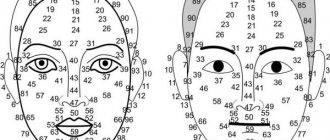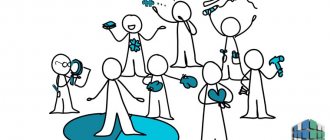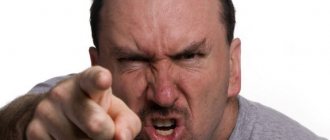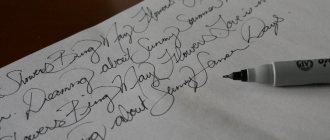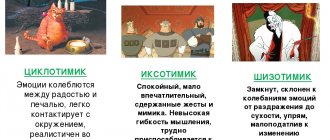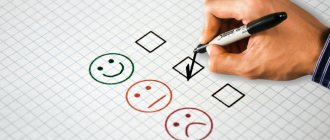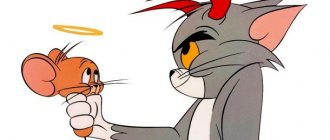Physiognomy is a psychological science with the help of which one can examine and analyze all facial features as a whole, and determine which of them are predominant for a particular person.
At first it will seem like fiction to you, but if you begin to practice this system in life, you will be amazed to discover how accurate the hits are sometimes and how sometimes the interpretations correspond to reality. As you gain experience, it is likely to develop a deep and almost instantaneous understanding of the reflection of the inner world on the face of the interlocutor.
Physiognomy – reading character traits from a person’s face
How did facial physiognomy appear?
The art of face reading - facial physiognomy - originated in ancient China, known as physiognomy, and has been practiced in one form or another for many centuries in different parts of the world.
According to the original Chinese school of thought, facial characteristics reveal the entire history of a person's personality, temperament and destiny. Timothy Map, one of the masters of physiognomy, states: “The face is a map of the past, present and future.”
A specialist in physiognomy will never confuse a person who is loved with a person who is not loved by anyone, a virtuous person with an immoral one and vice versa. What the face expresses exists for the world to see.
Let's look at some basics to understand how the art of face reading can help you find a more perfect and suitable lover.
The face captures not only the history of a person, but also his character and temperament - individual traits that are so necessary to recognize in those we can love.
Definition of the concept
The name is derived from two Greek words: physis, which means “nature,” and gnomon, which translates as “thought,” “the ability to know.” Physiognomy is a science that determines personality type, character and health characteristics by analyzing the physiological characteristics of the face. It is sometimes called the science of the face.
Ancient China is considered the birthplace of this trend. Then physiognomy came to Ancient Greece, and then spread throughout the East. In Eastern practices, physiognomy was considered as a branch of medicine. The first mentions of the physiognomy we are talking about today are found in the 6th century. BC. And the first person to use the concept of “physiognomy” is considered to be Hippocrates.
Interesting! There is still no single definition and terminological apparatus of physiognomy; it is impossible to name the pioneer of the direction. This makes some people even more doubtful about the validity and justification of this method of studying personality.
Face shapes in physiognomy
There are five basic face shapes, and each can tell something about a person's overall character.
Round or oval face (1)
A good owner, loves comfort and luxury. Friendly, has strong judgment and intuition, has certain values and a strong sense of justice. Capable, working hard in business, but sometimes giving in to laziness and self-justification.
Typically, this form speaks of a carefree, cheerful, good-natured person who loves manifestations of comfort in life: physical comfort, the sensations of touching things, good food. People with round faces tend to be good lovers. This face shape corresponds to the endomorphic type.
Triangular or heart-shaped face (2)
Smart, intelligent, has a good memory, mood swings are possible. Trying to make dreams come true can be impractical. Sensitive, introspective, easily lost interest and bored, he constantly needs a sense of purpose.
This shape reflects a sensitive personality, especially if the person is thin and does not have a double chin. The tighter the skin is, the more sensitive the person is.
An individual of this type may be an introvert, but at the same time he is extremely intelligent. People with triangular faces can be dreamy, or they can be insidious, they can be jealous and not be faithful to their loved ones. This form corresponds to the ectomorphic type.
Square or rectangular face (3)
A natural leader, agile, conscientious, always strives to be active. Intelligent, practical, has a variety of skills. He is physically strong and also has a strong will; he expresses his opinions harshly and decisively.
This form reflects a stern, unyielding personality, perhaps quite short-tempered. People with this face shape are possible leaders and warriors; They are usually frank in both business and love affairs and strive for success. A square face corresponds to the mesomorphic type.
Mixed round-triangular face (4)
Combines good intelligence with a healthy commercial sense, but lacks prudence. Inventive, optimistic, self-confident, but can be complacent.
Mixed triangle-square. Versatile, impulsive, quick-witted. Turns ideas into actions and generates income from activities. Mixed square and round. Very active, with a cheerful, carefree character. Selfish and self-willed, but very businesslike.
Eyes are the mirror of the soul
Even if you were skeptical about all of the above, it will be difficult for you to argue with the fact that our eyes are the “windows of the soul.” Without being a physiognomist, you can roughly describe a person’s character by looking at their eyes.
Large eyes are traditionally a sign of leadership and courage. Small eyes are often found in uncommunicative and stubborn people.
Calm, peaceful people have a wide iris. In nervous types it is often small.
You can't ignore their color:
- green - for persistent people;
- brown - for those who are very energetic;
- blue - for calm ones;
- light brown - for the modest ones.
The location of the eyes and the direction of their main axes is what all physiognomists love to look at.
- Downward-pointing corners of the eyes indicate a tendency to act rashly.
- Slightly drooping eyelids indicate excess energy.
- Swelling in the lower eyelid is a sign of a wild life.
- Swollen eyelids - fatigue.
The amazing Japanese have counted 40 types of eyes!
- The dragon's eyes are large. People in power have these kinds of things.
- Leaders, present and future, have the eyes of a lion.
What does your face shape mean?
Long face
A long face indicates a lover who will achieve success in life. This face shape can often be seen among aristocrats and people in power.
These are strong, energetic natures, often with a life position that seems to say: “I deserve the best.” The deeper you explore the face of your loved one, the better you will know his true essence. Therefore, let's “dig deeper”, consider and analyze the main areas of a person’s face.
Trapezoidal face
With a wide forehead and a narrow (but not pointed) chin, a trapezoidal face indicates a non-aggressive personality, a person with superior intellect and artistic ability.
Face Profiles
Convex profile(s)
A great enthusiast, he can be irritable and find it difficult to concentrate. Smart, practical and witty. He is very active, talks a lot, but does not like to listen.
Straight profile (b)
Always looking for the best, rarely losing. Calm and reasonable, but can be stubborn and self-confident. An inquisitive mind with a penchant for getting to the bottom of things.
Concave profile (c)
He may seem thoughtful and preoccupied with important issues, but in fact he is a superficial, shallow mind, absorbed in trifles. Reserved, reserved, almost sullen, but loyal and endowed with a good memory.
What does your nose say about your character?
This part of the face is responsible for a person’s vital and spiritual energy. Physiognomists even describe the ideal nose - symmetrical, with even wings and a rounded tip.
- A long nose belongs to original people.
- A crooked nose is for the strong in spirit.
- A thin, bony nose is for the arrogant.
- A snub-nosed, short nose is for people with an open soul.
The nostrils and tip of the nose can also say a lot about a person's personality.
- Large nostrils - a person with mental defects.
- The forked tip is for timid people.
- Small nostrils - prone to giving up quickly.
A nose turned up speaks of an unrestrained, capricious person. A woman’s large nose sometimes speaks of her wild life in her youth.
Main areas of the face and human character
There are three main zones in every person's face; they are proportional and balanced, although in reality the “ideal” rarely exists. Zone 1 – upper zone – the area from the hairline to the eyebrows. Zone 2 - the middle zone - extends from the eyebrows to the base of the upper lip. Zone 3 - the lower zone - includes the area from the base of the upper lip to the bottom of the chin.
Zone 1. Upper zone
The forehead indicates intellectual abilities. A well-developed forehead usually indicates a person's intelligence. Ideally, the ears should be spaced far apart and the forehead should be long and high.
Zone 2. Middle zone
If the middle zone of the face is long - with a high forehead and a long lower zone - the person has noble qualities. If the middle zone is too long compared to the other zones, the person may be arrogant but endowed with an enterprising spirit.
If the middle zone is in ideal (equal) proportion with the other zones, that person is likely to live a long time.
Zone 3. Lower zone
If the lower zone is longer than the other zones and is also strong, wide and perhaps fleshy, this indicates success and prosperity in life. If the chin is long and pointed, the person may need to change their outlook on life and learn to get along with others.
People with this type of lower zone should pay attention to science or philosophy, as well as the humanities, where they can find more spiritual knowledge.
A long and wide lower zone indicates a person who pays great attention to physical qualities. A too narrow lower zone indicates that a person is more concerned about the inner world than the physical side, and in matters of love he is characterized by a rich imagination.
Each part of any of the three zones of the face has its own signals and signs, its own significance and its own meaning for emotional life. The art of face reading is not limited only to the shape of the face and its zones; for a more complete picture, of course, you need to take into account the shape of the eyes, eyebrows, nose and lips, for this you will need additional literature.
Fortune telling by face
Find out what awaits you today - Horoscope for today for all zodiac signs
Due to numerous requests from subscribers, we have prepared an accurate horoscope application for mobile phones. Forecasts will arrive for your zodiac sign every morning - it's impossible to miss! Download for free: Daily Horoscope 2020 (available on Android)
Physiognomy is precisely fortune telling by face. This is exactly what the literal translation of the name of this field of knowledge from Greek sounds like. Its first adherent was Galen, who believed that our appearance can say a lot about our inner world. By the way, the definitions of other psychologists, philosophers and other scientists are not so different from the above.
Many adherents of this pseudoscience even today “read” many of his desires and aspirations by his face. They believe that such skills help to anticipate particular human behavior. Perhaps such specialists even derive some benefit from this.
Japanese tradition of physiognomy
In the West, this science originated in Greece, and in the East - in China. From China it spread throughout Asia. It is very interesting that facial physiognomy has become widespread in Japan. How else can we explain the culture of beautiful theatrical masks of Japanese theater?
To understand something about a person from his face, the Japanese speculatively divide this part of the body into three parts:
- top;
- average;
- lower
The top of the face, the forehead, turns out to be able to tell us almost more than the rest of the face about the years we have lived. Which, however, is not surprising. The condition of your forehead can say a lot about you between the ages of 15 and 30.
- Smooth, beautiful skin on the forehead means a person is healthy physically and spiritually.
Life between the ages of 35 and 40 most affects the middle part of the face (from the eyebrow arches to the tip of the nose).
- A harmonious life, full of health and carnal joys, is expressed by a correct, orderly middle zone, without asymmetries and creases.
The lower zone is responsible for the age from 50 to 70 years, which is very logical. There are wrinkles and downturned corners of the mouth.
- Balanced, calm people age beautifully in this zone.
Of course, “reading a face” using this scheme is not as simple as it seems. This needs to be learned. But I think that once you start reading about Japanese physiognomy, you will discover a lot of interesting things and learn even more about your family and friends, whose faces surround you every day.
What does the shape of the forehead, eyebrows, nose, eyes, ears, mouth mean?
The meaning of forehead height and shape
High - Intellectual. Tall and wide (1) - Characteristic of a philosopher. Tall and narrow - Analytical. Low (2) - Practical, direct, immediate. Convex - Observant, executive. Direct (3) - Cautious, circumspect, good concentration. Concave - Good listener, helpful.
The meaning of eyebrow shape
Thick (4) - Impressive, rough, direct. Subtle - Refined, nervous. Direct (5) - Alive, active. Curved - Inquisitive, inquisitive. Arc-shaped (“arch”) - Possessing a rich imagination.
Rising Up (b) - Ambitious. Those going down - Submissive, uncomplaining. Widely spaced - Easily adaptable, susceptible to influences. Fused - Full of energy.
Meaning of eye shape
Round - Naive, trusting. Oval - Insight, good nature. Slanted (7) - Secretive, self-indulgent. Wide open (8) - Trust, friendly disposition. With closed eyelids (9) - Intrigue, envy. Narrowed Interest, suspicion. Broad-minded - Self-confident, big-minded.
Closely located - Responsible, narrow-minded. Convex - Well-spoken, resourceful and witty. Deep-set (10) - Speaks slowly, insists on facts. Neither prominent nor deep-set - Persuasive speaker and good listener.
The meaning of nose size and shape
Large - Aggressive, experienced, sophisticated. Small - Quiet, modest, unassuming. Subtle - Nervous, irritable. Broad - Verbose, light-hearted. Long (11) - Caring, restless. Short (12) - Cheerful.
With a high bridge of the nose, with a hump (13) - Energetic, inquisitive. Direct - Balanced, thorough, organized. Short and snub-nosed (14) - Friendly, secretive, hardworking.
The importance of ear size and shape
Large - Intellectual. Small - Having a natural flair, instinctive. Longer than wide (15) - Getting carried away, impractical. Wider than it is long - Very practical. Pointed - Clever, cunning, turns a blind eye to everything.
Large earlobes (16) - Independent, intelligent, energetic. Small lobes - Dependent, lacking initiative. No earlobes (17) - Not responsive, lacks a sense of purpose. Closely adjacent to the head - Plans ahead, economical, thrifty. Ears stick out (18) - Original thinker.
The importance of mouth size and shape
Big - Generous, magnanimous, extravagant. Small - Selfish, stingy. Curved Up (19) - Cheerful. Bent down - Dissatisfied. Big lips (20) - Hedonistic. Thin lips - Low emotionality.
Straight lips - Tendency to self-control. Curved (wavy) lips (22) - Variability. Protruding upper lip Criticality, tendency to exaggerate. Protruding lower lip - Delicate, tactful, pleasant. In profile the lips are equal - limited, assertive, similar.
The importance of chin size and shape
Elongated - Stubbornness. Short - Variability. Pointed (23) - Enthusiasm. Split by a deep line (24) - Egocentrism. Double (24) - Friendly, self-indulgent. Cut - Argumentative, impatient, trivial. Dull (25) - Firm, almost emotionless, with a lively character hidden behind the calmness. Forward - Discreet, determined and stubborn.
Mouth and lips
This part of the human face, as a rule, determines the amount of internal energy of a person. The norm is a large mouth for men and a small mouth for women.
A large mouth is not perceived very well in women, because such ladies have a strong character. Alas, here, more than with other parts of the face, the rule works:
- people with small mouths are just trying to survive.
Thin lips indicate a closed character, lips falling down speak of a person with a strong will, such a person is difficult to influence.
Plump lips belong to successful people. A mouth curved into an arc indicates a person’s sensitivity. A stubborn person has one corner of his mouth downturned. Wrinkles on the upper part of the lip indicate a calm youth, but years of deprivation in adulthood.
Physiognomy about health
Even for beginners, physiognomy will help determine health by the condition of the skin, eyebrows and eyelashes. If they are perfect, there are no problems in the body.
A yellowish tint to the face indicates a problem with the gallbladder or liver. Unnatural pallor indicates anemia. If brown spots appear on your face, it is recommended to check your hormonal levels, kidneys, and gallbladder.
Vascular mesh on the cheeks occurs due to problems with blood vessels and pressure, on the wings of the nose - due to lung diseases.
Puffy eyelids can be the result of lack of sleep or frequent stress. Blue color around the eyes indicates lack of sleep or diseases of the kidneys and adrenal glands. You should check your bladder if your lower eyelid turns brown.
Thinning eyebrows are a sign of hormonal imbalance, as well as dysfunction of the thyroid gland. People with sparse eyelashes should monitor the functioning of the genitourinary system.
Blueness or pallor of the nasolabial triangle and around the lips is a hint of problems with the heart, blood vessels, blood circulation, lung disease or anemia. Often cracked corners of the lips indicate a lack of vitamins or allergies.
Hypertonicity and hypotonicity of facial expressions
They indicate the condition and excitability of the nervous system.
If a person exhibits hypertonicity of facial expressions (muscle tension) , and even more so, winces and tics, then this may indicate the presence of fears and problems that bother the person. This may only be a temporary phenomenon, but in general such people are sociable and energetic, they are good leaders.
Hypotonia (relaxed facial muscles) , as a rule, indicates a lazy person who lacks the desire to solve problems, he seems to be lacking energy. In the eyes of such people you can often notice apathy, the mouth is slightly open, and the eyes, on the contrary, are slightly closed.
Physiognomy at the present stage of development
Initially, physiognomists studied the features of the entire human body, but now facial features have become the focus of researchers.
In the field of view of researchers only congenital features of appearance:
- Shape, size, location of facial features
- Birthmarks
- Color of the skin
- The presence of various kinds of bulges and dents
- Wrinkle lines
- Scars
Convinced adherents of physiognomy believe that by learning to understand what information is embedded in facial features, you can learn a lot of new and useful information.
Oval face type: features
An oval face shape is considered the standard. It is precisely this type that makeup artists strive to adjust its contours to. It is possible to identify it in yourself if the measurements taken show:
- a clear predominance of facial length over width;
- jaws slightly narrower than forehead;
- The width of the forehead is less than the cheekbones.
A rounded chin gives a completed look to such a face.
Beauty experts consider an oval face to be the most proportional and harmonious.
As a rule, no attempt is made to correct this type. You can choose any haircut and styling for it. The “oval” face shape gives you freedom to experiment with your appearance in terms of using decorative cosmetics.
Women with an oval face type can safely experiment with decorative cosmetics
A woman who is its lucky owner can use a wider arsenal of cosmetics than other physiognomic types. However, makeup artists advise adhering to certain principles for their use. This will help make your appearance even brighter and more impressive.
Oval face – a wide field for cosmetic fantasies
Tips from makeup artists for ovals
Despite the proportionality of the facial parameters, “oval” ladies may need to level out the shortcomings of other elements of the “business card”. For example, make your eyes bigger, visually make your nose smaller, or hide your double chin. Without knowing the rules for applying makeup, you can ruin even the most ideal proportions.
With a harmonious oval face shape, decorative makeup tricks will allow you to veil the imperfections of other parts of the face
If, after examining an oval-shaped face in a photo or in the mirror, you decide that these tricks are not needed, you can just try to make it more prominent. Blush or highlighter will help with this. Experts advise applying to the most convex part of the cheekbones, and then blending towards the temple area.
To look even better, beauty experts advise applying blush to the most prominent part of your cheekbones.
“Ovals” will benefit from bright eye makeup using several tones. For outer corners - darker, for inner corners - light. Stylish smoky eyes makeup is also good for them, characterized by creating a hazy effect with a smooth flow of light shadows into dark ones.
Bright eye makeup is the best choice for women with oval face types.
Which celebrities are “ovals”
Many public figures - famous actresses, socialites, TV show hosts - have an oval or slightly elongated face shape. She gives them less problems with choosing makeup and jewelry than representatives of their professions with other types. They are suitable, for example, for any type of earrings from tiny studs to massive chandeliers and chandelier earrings.
Cindy Crawford - the owner of an oval face can afford tiny studs as a stylish decoration
For fashion shows on the red carpet, they always select the best looks, using the advice of experts. Those of them whose face shape is an elongated oval, as well as a long nose and high forehead and cheekbones, try to choose voluminous, short drop earrings and modest studs. They bring the contours closer to the ideal oval, visually expanding it.
Uma Thurman, the owner of an elongated oval face, chooses impeccable hairstyles and drop-shaped voluminous earrings
Owners of this type include Jennifer Aniston, Cindy Crawford, Sharon Stone, Uma Thurman, Julia Roberts. They appear on screen with different types of hairstyles and makeup. However, their heroines always look absolutely flawless.
Physiognomy - the queen of nonverbals
A study by scientists once again confirmed the effect of a person’s facial expression on the perception of those around him.
Therefore, it is so important that the interlocutor’s facial expression is interpreted correctly. Otherwise, instead of strengthening contact, aggression and mistrust may arise between the participants in the dialogue. Frown eyebrows and a wrinkled forehead in an attentively listening interlocutor can be regarded as a lack of interest, and even as dissatisfaction (the face may seem critical) and cause a response: defensive or aggressive.
Knowing about this peculiarity of perception, it is important to always remember this and watch your face. During communication, relax his muscles, open his eyes wider (instead of frowning). This expression is interpreted as the interlocutor’s interest in what is happening. You should not close your jaws, it is also better to relax your lips. Tightly pursed lips during a conversation are usually regarded as an attempt at verbal aggression. Forehead muscle tension must be relieved constantly throughout the entire period of communication.
You should not try to look like an interested interlocutor during a conversation. You need to become one! To be interested means to be attentive. What and how does the partner say, what gestures does he use? Careful observation of the speaker's facial expressions and gestures during a conversation will help us understand him better, find out what he really feels and how he feels about certain moments and phenomena.
Considering the fact that about 75% of non-verbal information is transmitted through facial expression, it is necessary to learn not only to correctly read this information, but also to adequately convey emotions ourselves. In order to be understood and better understand others, it is important to maintain your attention and interest in the interlocutor during the communication process.
Physiognomy: Let's destroy the myths
Over the centuries-old history of physiognomy, many unproven facts and exaggerations have accumulated.
The most common misconceptions:
- It is mistakenly believed that those with a perfectly symmetrical face always have a happy destiny. Actually this is not true. Research has shown that there are practically no people in the world with absolutely symmetrical halves of the face. Some physiognomists believe that such people have good health, others call this phenomenon a sign of approaching death.
- A vertical wrinkle located in the center of the forehead is a sure sign of poverty. This interpretation is not entirely correct, since this mark indicates an intellectually and creatively gifted person.
- The brow ridges hanging over the eyes and a strongly protruding lower jaw are typical facial features of a criminal; this misconception, thanks to the light hand of criminologist Cesare Lombroso, lasted for quite a long time. But modern physiognomists have completely refuted it.
- The statement that a large skull indicates a person’s talent was found to be erroneous. The researchers concluded that there is no direct relationship between mental ability and talent and the size of the skull.
Forehead
The same Aristotle, who was interested in facial physiognomy along with Hippocrates and Theophrastus, wrote:
“If people have large foreheads, then they are slow; if they have wide foreheads, one should be wary of insanity; rounded or convex foreheads indicate hot temper.”
In general, the forehead in popular consciousness has always been correlated with the mind and intellect : “He was seven spans in the forehead...”. Sometimes you can also read the worldview and personal philosophy of an individual from the forehead.
Talented intellectuals can boast of high, wide foreheads. But if height is combined with a long and elongated face, we have to talk about cruelty and a tendency to violence. A short, narrow forehead does not bode well for great intelligence, but we may face a hardworking, scrupulous owner and not a weak-willed person.
Physiognomic analysis
Physiognomic analysis is used in cases where it is necessary to quickly form a correct impression about a practically unknown person (for example, at an interview or at a first meeting).
The main advantage of this method is that the interlocutor will not even know that he is the object of study for you. This means that you will be able to find out information that is valuable to you, while maintaining complete confidentiality.
Physiognomy - eyes (character according to eye shape)
Eyes are the mirror of the soul. It is so? Looks can be read like an open book. Yes, and they don’t seem to know how to lie?
For an unkind glance from under your brows, called black , in medieval Russia you could be considered a witch. The eyes were always mesmerizing. They are bottomless, and witchcraft, and brilliant, like stars. symbolic meaning in literature .
And therefore they can tell about the qualities of the spirit and the inclination to creativity. Big eyes reveal a person with the makings of a leader. Convex ones, sometimes called dragonflies, will tell the observer about the internal laziness and slowness of their owner. Are your eyes sunken? The person is suspicious, prone to taking offense, often gets angry, and one can even talk about his hidden hostility towards others.
Why is it important to know your face type?
Just as it is important to correctly determine your body type when choosing clothes, to optimally select the remaining components of the image, you need to determine your face type. Accurate determination of the proportions and shape of a woman’s face will allow her to use the most suitable arsenal of tools that help hide flaws and emphasize the advantages of her appearance.
Experts advise establishing that your “business card” belongs to one of the established types as early as possible. In this case, a woman from a young age will be able to develop her own unique style, which will distinguish her favorably from those around her. There are various classifications in which different names are assigned to a certain type. However, this does not change the essence of categorizing the form.
For the perfect selection of makeup and hairstyle, facial proportions are important. Experts have determined what types of faces exist. By correlating the significant parameters, they derived 7 main types.
Let's summarize
Let me remind you once again that physiognomy is officially considered a pseudoscience. Which, however, does not make it prohibited. To understand a person’s character from a person’s appearance, a physiognomist carefully looks and studies the face, tracing his emotions.
- To assess a person’s character, the Japanese speculatively divide his face into three parts and evaluate each part according to special criteria.
- The frontal part can say a lot about a person. Wrinkles, skin color - all this plays a role.
- Eyes and eyebrows say about us even more than we ourselves want: the shape of the eyebrows, the axis of hair growth, the color of the eyes and their location can express our most obvious character traits.
- Mouths and noses come in all shapes and sizes and also reflect our emotionality, amount of vitality and character type.
Dynamics of facial features with human age
Usually, with the help of the senses, information from the outside world is most actively received by a child under the age of 6 years. Using these organs, the baby tries to use his eyes as much as possible to view the world, his ears to hear, his nose to explore common smells, and his mouth to experience new tastes.
But as one gets used to the world around him, the intensity of feelings decreases; a person no longer needs them so much. Soon it becomes increasingly difficult for him to rebuild his perception in constantly changing situations, and all the emotions he experiences are reflected on his face, which becomes less and less mobile.
A person, having ceased to be a child, is not so interested in everything that happens around him and, over time, withdraws into himself. But this time is different for everyone, that is, the dynamics of facial features flows at different speeds for each individual.
